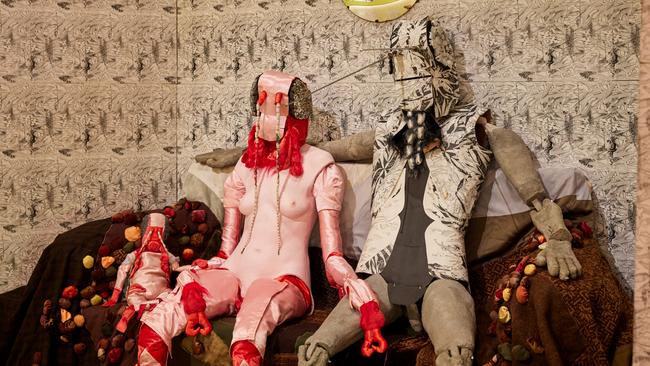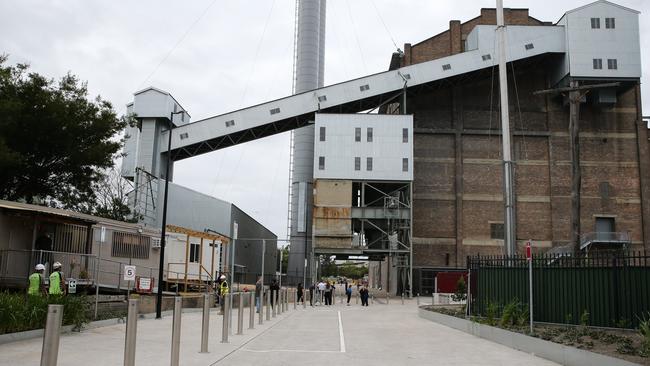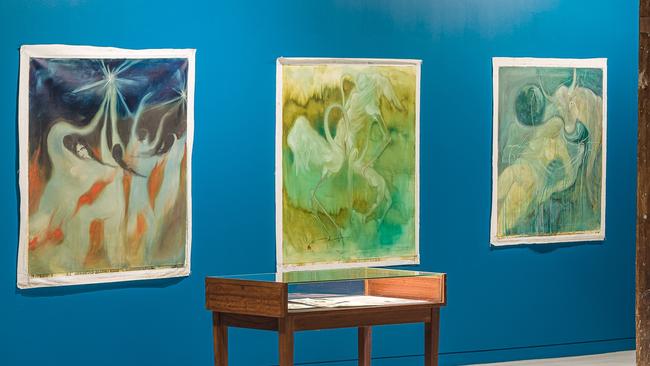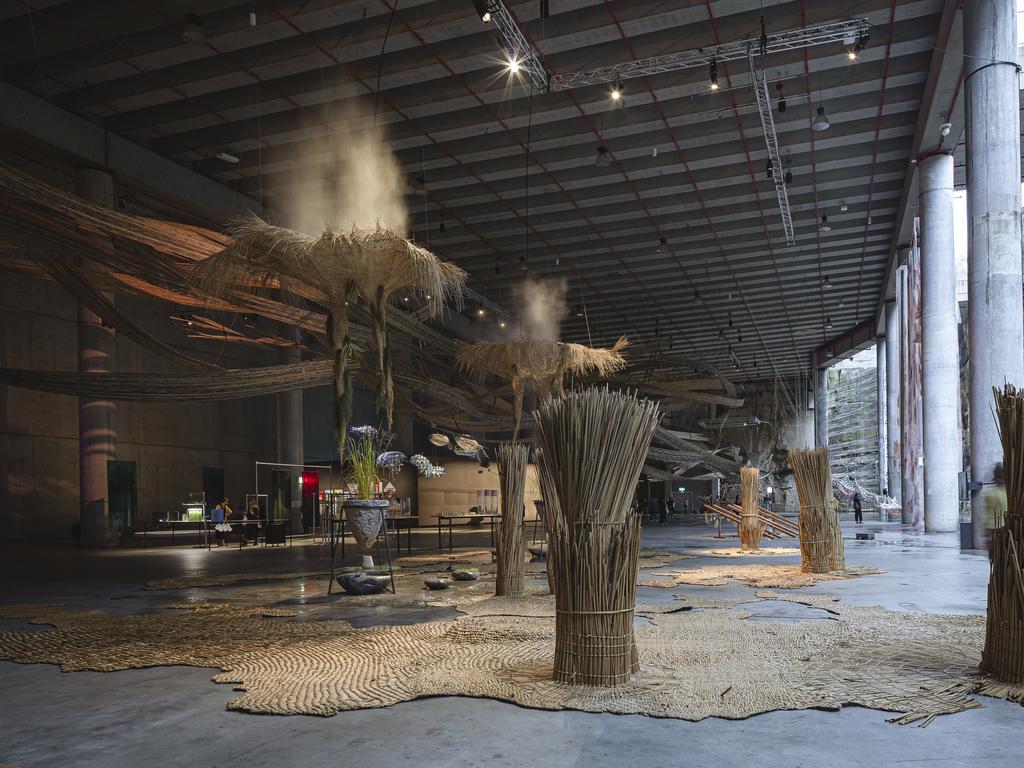Sydney’s Biennale is behind the times and lost in escapism
This year’s Biennale of Sydney is caught up in subversive but misguided views on colonialism.

The bus trip to White Bay Power Station is a short and convenient ride from Queen Victoria Building, and pleasant enough on a fine day, if not comparable to the ferry excursion to Cockatoo Island in past years. The old power station itself, used for the first time this year, is also interesting, although again nothing like as beautiful a natural site, or as complex, diverse and rich in historical layers as Cockatoo Island.

White Bay was built in the years before and during the Great War, particularly to power the growing network of electric trams and trains in Sydney, so it played an essential role in supporting transport and enabling the growth of the city. It generated electricity until the end of 1983, after which it was decommissioned and eventually listed as a heritage structure to be preserved and used for cultural purposes.
The Biennale has long relied on former industrial sites to supplement the interest of the exhibitions themselves, and many of the works shown at Cockatoo Island would have had far less impact in a conventional gallery space; sometimes this was because of the relationship set up between the works and the environments, but all too often it was the qualities of the site that made up for the indifference of the work.

The last Biennale, shown at the Cutaway at Barangaroo, made good use of a vast new space, but it was dominated by equally gigantic works of a kind that can only exist in the entirely artificial environment of a large-scale but temporary exhibition. It was art as a kind of theatrical experience, addressed to large crowds but with little enduring afterlife.
There is nothing like this massive theatrical scale in the works shown this year at the power station; many pieces are too big for the quality of their content, but they never convey a sense of grandeur. This is partly because the power station does not offer the variety of interiors and contained spaces that were available at Cockatoo Island, so that even oversized pieces can be dwarfed by the amorphous space around them; and because of the lack of separate spaces, one thing drifts into another without clear distinction of setting.
At the same time the work is generally disappointing in quality. The first thing we encounter is a series of bland abstract paintings which, as their label informs us, express rich traditions of black music-making. Nearby are hangings of Brazilian decorative textiles, and an installation of kitsch. And this sets the tone for the whole exhibition.
Some of the work shown elsewhere is more substantial; most memorable, at the Museum of Contemporary Art, is a collection of outtakes from an Armenian historical film censored in the Soviet period; on the opposite wall is a group of contemporary Chinese ink paintings. William Strutt’s famous painting Black Thursday, 1851 (1864), however, is displayed with a blatantly dishonest label claiming that the catastrophic bushfires occurred because settlement had put an end to traditional Indigenous burning practices; in fact Black Thursday was in the very early years of settlement in Victoria, and was caused by a severe drought followed by an extreme heatwave.
![Cristina Flores Pescorán’s Diario [Diary], 2022.](https://content.api.news/v3/images/bin/a7debb0a23fd5618226aeaa09ca2ec1a?width=650)
Of course we should have known what to expect from the first press release, issued last year: Artistic Directors Cosmin Costinaș and Inti Guerrero said: “Ten Thousand Suns departs from an acknowledgment of a multiplicity of perspectives, cosmologies, and ways of life that have always woven together the world under the sun. A multiplicity of suns conveys an ambiguous image … But it also conveys the joy of cultural multiplicities affirmed, of First Nations understandings of the cosmos brought to the fore, and of carnivals as forms of resistance in contexts that have surpassed colonial oppression.”
If you are wondering why, after so many ideological buzzwords, the curators omitted “capitalist”, it appears in the second paragraph, where they acknowledge “the deep ecological crises derived from colonial and capitalist exploitation while refusing to concede to an apocalyptic vision of the future. The 24th Biennale of Sydney proposes instead solar and radiant forms of resistance that affirm collective possibilities around a future that is not only possible, but necessary to be lived in joy and plenitude.”
The argument against “an apocalyptic vision of the future” is reiterated in one of the exhibition labels at the power station, and this pessimistic outlook is implicitly ascribed to capitalism and “the west”, whatever those labels are meant to signify today. It is unclear what the curators make of Greta Thunberg, or of Bonita Ely’s apocalyptic installation of locust-people in the section of the Biennale at the Art Gallery of NSW.
One may well ask what vision of the future the curators have, or even what understanding of present realities. An installation at the power station is dedicated to a group of women called VNS Matrix, formed in 1991, who produced a text entitled “A Cyberfeminist manifesto for the 21st century”. We are assured that this has remained “influential in feminist discourse” and that it has “laid foundational groundwork in feminist thought”. The truth, however, is that the entire digital and online world that we now inhabit has evolved since their time, and that posters sneering “suck my code” are pitiful in the exploding universe of artificial intelligence.
A similarly obtuse attitude to modern medicine is expressed in the text accompanying one of the few aesthetically interesting and touching works at the power station, a video in which the artist opens a woven mesh into a sort of mask. This was inspired by an early experience of skin cancer, but we are told that she has dedicated “a lifetime to healing her illness and investigating alternatives to the aggression of Western medical interventions” – even though these likely saved her life – and that she “imagines a cure not as a treatment but as a dialogue between body and ancestry, rooted in the restorative processes of nature”.
But the most bizarre text, at the entrance to the power station, declares “this gigantic empty shell, where mountains of coal were brought and burnt, is a monument to the absurd effort that has been needed to power the settler colony.” We may need a moment to digest the stupidity of this statement, to ponder who wrote these words, who edited them, who approved them for display at the exhibition site.
Perhaps none of them has stopped to think that a great deal of “effort” goes into keeping any city running, and that they all benefit from it. Since we are speaking specifically of electricity, one imagines that even Biennale apparatchiks expect the trains to keep running, the fridge to work in their flat, to be able to recharge their mobile phones; how distressing it would be if they couldn’t call an Uber.
Do they really believe the “effort” to provide the electricity they count on at every point in their daily lives is “absurd”?

Have they considered that our current efforts to generate electricity without burning fossil fuels are in fact considerably greater? Presumably they don’t consider this additional effort absurd. Or do they imagine that life was better before the settlers came here and started making their absurd efforts?
This Biennale, even more than its predecessors, has succumbed to ideology and moral posturing. Beyond and as we know often in conflict with feminism is the infatuation with an idea of “queerness”. So-called queer art has always remained marginal because many of the greatest artists of the past already had complex and fluid sexual lives, without being boxed into the categories that were imposed over the past century and have now multiplied into ever more alphabetical sub-identities.
What is curious here is to see how “queer” is trying to gain greater traction or legitimacy by assimilating the Indigenous, even though nothing could be more antithetical to the values of “queer” than traditional Aboriginal society with its patriarchal and authoritarian structure and rigidly defined and enforced gender roles. The idea of “black queer” is a postcultural hybrid spawned by an alienated urban environment.
But this spurious assimilation is also significant because the main ideological program of this Biennale is to deplore “colonialism”, supposedly the cause of all the woes of the contemporary world, from injustice to climate change. Wall texts and labels throughout claim credibility for various indifferent exhibits on the grounds that they are critiques of colonialism or settler culture.
As I have said before, the Left hates colonists and settlers, but loves migrants and refugees; and yet all of these are overlapping categories, if not ultimately the same thing in the long course of history – and certainly in the case of Australia.
Population movements, settlement, empires and colonisation are, historically speaking, simply ways that civilisations have been brought to less developed peoples, and that knowledge and technology have been shared across humanity for thousands of years. All historical processes involve confrontations and therefore injustices; these should not be denied, but they are ultimately incidental to the greater movements of which they are a part.
The idea that we could even begin to feed ourselves without modern farming techniques is ludicrous; we cannot imagine a life without literacy, books, science, technology, medicine, philosophy and critical thought.
And yet, as we have seen, this exhibition is steeped in an ideology of deluded nostalgia for the past. The very idea of modern or contemporary art seems to have been consumed by this ideology.
Above all, this year’s Biennale confirms that the cultural establishment is radically out of touch with what is really happening in the contemporary world, whether politically, socially or culturally.
Their yearning for primitivism is not a form of critical “resistance” as they would like to believe, but a futile and self-indulgent escapism.
Biennale of Sydney
White City Power Station and other venues, until June 10
Biennale of Sydney
White City Power Station and other venues







To join the conversation, please log in. Don't have an account? Register
Join the conversation, you are commenting as Logout